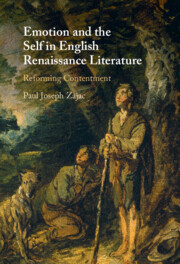16 results
Copyright page
-
- Book:
- Emotion and the Self in English Renaissance Literature
- Published online:
- 15 December 2022
- Print publication:
- 22 December 2022, pp iv-iv
-
- Chapter
- Export citation
Acknowledgments
-
- Book:
- Emotion and the Self in English Renaissance Literature
- Published online:
- 15 December 2022
- Print publication:
- 22 December 2022, pp viii-x
-
- Chapter
- Export citation
Chapter 1 - Constructing Contentment in Reformation England
-
- Book:
- Emotion and the Self in English Renaissance Literature
- Published online:
- 15 December 2022
- Print publication:
- 22 December 2022, pp 20-49
-
- Chapter
- Export citation
Chapter 3 - Fashioning Contentment
-
- Book:
- Emotion and the Self in English Renaissance Literature
- Published online:
- 15 December 2022
- Print publication:
- 22 December 2022, pp 76-100
-
- Chapter
- Export citation
Chapter 4 - Performing Contentment
-
- Book:
- Emotion and the Self in English Renaissance Literature
- Published online:
- 15 December 2022
- Print publication:
- 22 December 2022, pp 101-124
-
- Chapter
- Export citation
Notes
-
- Book:
- Emotion and the Self in English Renaissance Literature
- Published online:
- 15 December 2022
- Print publication:
- 22 December 2022, pp 156-201
-
- Chapter
- Export citation
Dedication
-
- Book:
- Emotion and the Self in English Renaissance Literature
- Published online:
- 15 December 2022
- Print publication:
- 22 December 2022, pp v-vi
-
- Chapter
- Export citation
Introduction
-
- Book:
- Emotion and the Self in English Renaissance Literature
- Published online:
- 15 December 2022
- Print publication:
- 22 December 2022, pp 1-19
-
- Chapter
- Export citation
Chapter 2 - Romancing Contentment
-
- Book:
- Emotion and the Self in English Renaissance Literature
- Published online:
- 15 December 2022
- Print publication:
- 22 December 2022, pp 50-75
-
- Chapter
- Export citation
Secondary Sources
-
- Book:
- Emotion and the Self in English Renaissance Literature
- Published online:
- 15 December 2022
- Print publication:
- 22 December 2022, pp 205-225
-
- Chapter
- Export citation
Index
-
- Book:
- Emotion and the Self in English Renaissance Literature
- Published online:
- 15 December 2022
- Print publication:
- 22 December 2022, pp 226-230
-
- Chapter
- Export citation
Chapter 5 - Losing Contentment
-
- Book:
- Emotion and the Self in English Renaissance Literature
- Published online:
- 15 December 2022
- Print publication:
- 22 December 2022, pp 125-152
-
- Chapter
- Export citation
Contents
-
- Book:
- Emotion and the Self in English Renaissance Literature
- Published online:
- 15 December 2022
- Print publication:
- 22 December 2022, pp vii-vii
-
- Chapter
- Export citation
Conclusion
-
- Book:
- Emotion and the Self in English Renaissance Literature
- Published online:
- 15 December 2022
- Print publication:
- 22 December 2022, pp 153-155
-
- Chapter
- Export citation
Bibliography
-
- Book:
- Emotion and the Self in English Renaissance Literature
- Published online:
- 15 December 2022
- Print publication:
- 22 December 2022, pp 202-204
-
- Chapter
- Export citation

Emotion and the Self in English Renaissance Literature
- Reforming Contentment
-
- Published online:
- 15 December 2022
- Print publication:
- 22 December 2022



